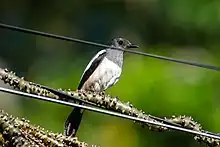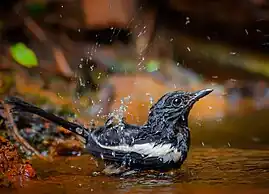| Philippine magpie-robin | |
|---|---|
 | |
| Scientific classification | |
| Domain: | Eukaryota |
| Kingdom: | Animalia |
| Phylum: | Chordata |
| Class: | Aves |
| Order: | Passeriformes |
| Family: | Muscicapidae |
| Genus: | Copsychus |
| Species: | C. mindanensis |
| Binomial name | |
| Copsychus mindanensis (Boddaert, 1783) | |
The Philippine magpie-robin (Copsychus mindanensis) is a species of bird in the family Muscicapidae. It is endemic to the Philippines. It used to be considered a subspecies of the Oriental magpie-robin.
Its natural habitats are subtropical or tropical dry forests and subtropical or tropical moist lowland forests.

Taxonomy
The Philippine magpie-robin was described by the French polymath Georges-Louis Leclerc, Comte de Buffon in 1775 in his Histoire Naturelle des Oiseaux from a specimen collected on the island of Mindanao in the Philippines.[2] The bird was also illustrated in a hand-coloured plate engraved by François-Nicolas Martinet in the Planches Enluminées D'Histoire Naturelle which was produced under the supervision of Edme-Louis Daubenton to accompany Buffon's text.[3] Neither the plate caption nor Buffon's description included a scientific name but in 1783 the Dutch naturalist Pieter Boddaert coined the binomial name Turdus mindanensis in his catalogue of the Planches Enluminées.[4] The Philippine magpie-robin is now one of 12 species placed in the genus Copsychus that was introduced by the German naturalist Johann Georg Wagler in 1827.[5][6] It was formerly considered as a subspecies of the oriental magpie-robin (Copsychus saularis) but was promoted to species status based on the results of a molecular phylogenetic study that was published in 2009.[6][7] The species is monotypic.[6] The genus name Copsychus is from the Ancient Greek kopsukhos or kopsikhos for a "blackbird". The specific mindanensis comes from "Mindanao", the type locality.[8]
References
- ↑ BirdLife International. (2016). "Copsychus mindanensis". IUCN Red List of Threatened Species. 2016: e.T103893527A104347211. doi:10.2305/IUCN.UK.2016-3.RLTS.T103893527A104347211.en. Retrieved 24 May 2018.
- ↑ Buffon, Georges-Louis Leclerc de (1775). "Le merle de Mindanao". Histoire Naturelle des Oiseaux (in French). Vol. 6. Paris: De L'Imprimerie Royale. pp. 83–84.
- ↑ Buffon, Georges-Louis Leclerc de; Martinet, François-Nicolas; Daubenton, Edme-Louis; Daubenton, Louis-Jean-Marie (1765–1783). "Merle de Mindanao". Planches Enluminées D'Histoire Naturelle. Vol. 7. Paris: De L'Imprimerie Royale. Plate 627 Fig. 1.
- ↑ Boddaert, Pieter (1783). Table des planches enluminéez d'histoire naturelle de M. D'Aubenton : avec les denominations de M.M. de Buffon, Brisson, Edwards, Linnaeus et Latham, precedé d'une notice des principaux ouvrages zoologiques enluminés (in French). Utrecht. p. 38, Number 627 Fig. 1.
- ↑ Wagler, Johann Georg (1827). Systema avium (in Latin). Stuttgart: J.G. Cottae. p. 306 (Gracula).
- 1 2 3 Gill, Frank; Donsker, David, eds. (2019). "Chats, Old World flycatchers". IOC World Bird List Version 9.2. International Ornithologists' Union. Retrieved 1 September 2019.
- ↑ Sheldon, F.H.; Lohman, D.J.; Lim, H.C.; Zou, F.; Goodman, S.M.; Prawiradilaga, D.M.; Winker, K.; Brailem, T.M.; Moyle, R.G. (2009). "Phylogeography of the magpie-robin species complex (Aves: Turdidae: Copsychus) reveals a Philippine species, an interesting isolating barrier and unusual dispersal patterns in the Indian Ocean and Southeast Asia". Journal of Biogeography. 36 (6): 1070–1083. doi:10.1111/j.1365-2699.2009.02087.x. S2CID 55529997.
- ↑ Jobling, James A. (2010). The Helm Dictionary of Scientific Bird Names. London: Christopher Helm. pp. 117, 255. ISBN 978-1-4081-2501-4.
